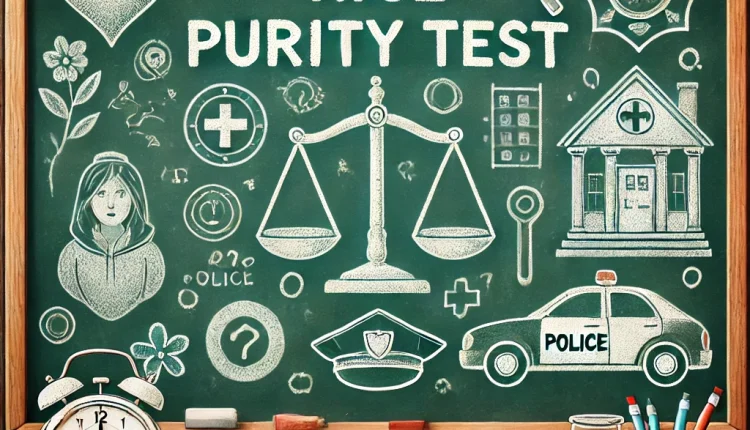The Rice Purity Test is a self-assessment quiz that has gained popularity among high school and college students, particularly in the United States. The quiz comprises 100 questions that gauge a person’s innocence or life experiences across various categories, including relationships, substance use, criminal behavior, and other personal activities. With the rising popularity of internet culture, this test has become a rite of passage for many, though it remains light-hearted and informal.
What Is the Rice Purity Test?
The Rice Purity Test is essentially a checklist where participants have to tick off the experiences they have from a list of 100 questions. Each question is phrased as “Have you ever…?” and covers a wide range of activities, from the relatively innocuous (such as holding hands) to the more extreme (such as being arrested). Once all questions are answered, the person receives a score out of 100, where a higher score indicates greater purity or innocence, and a lower score suggests more life experiences.
For example, a score of 90+ would indicate a relatively “pure” individual who has had fewer adventurous or potentially controversial experiences, whereas a score below 30 would suggest that the person has engaged in a wider variety of life events, particularly those considered risky or taboo by societal standards.
The Origins of the Rice Purity Test
The Rice Purity Test originated at Rice University, a prestigious private university located in Houston, Texas. It was first introduced in the 1920s as a way to foster bonding among students, particularly incoming freshmen, who were encouraged to take the test as part of orientation activities. Initially, the test was designed to be a humorous icebreaker, allowing students to reveal certain personal experiences in a non-judgmental way. Over time, it evolved into a more playful, yet somewhat revealing, assessment that continues to be popular even outside Rice University.
Despite its roots in humor and student culture, the test also serves as an indicator of how different social and cultural environments shape people’s experiences, as well as how they view certain life choices and activities.
Categories Covered in the Test
The Rice Purity Test touches on various aspects of life experiences, divided broadly into several categories:
1. Romantic and Sexual Experiences
This category includes questions related to kissing, dating, sexual intercourse, and other forms of physical intimacy.
2. Substance Use
Questions here pertain to alcohol consumption, recreational drug use, and smoking.
3. Legal and Criminal Behavior
Participants are asked if they’ve been involved in illegal activities, ranging from petty crimes like vandalism to more serious offenses such as theft or being arrested.
4. Social and Partying Behavior
This section covers experiences at parties, with questions asking about public intoxication, attending large gatherings, or participating in wild events.
5. Personal Morality and Ethical Choices
A smaller portion of the quiz touches on matters like dishonesty, cheating in school, or other moral decisions.
Why Do People Take the Rice Purity Test?
For many, the Rice Test Purity is a fun way to reflect on their journey and compare their experiences with others in a light-hearted manner. Among high school and college students, it often becomes a conversation starter or a humorous way to gauge where someone falls on the spectrum of innocence. Additionally, the test can provide a sense of belonging within a group, particularly in the context of university life, where new students are trying to connect.
The competitive aspect also adds to the allure. People sometimes take the test repeatedly to see how their scores change as they gain new experiences over time.
How Is the Rice Purity Test Scored?
All participants score the Rice Purity Test by answering 100 “yes” or “no” questions about a person’s life experiences, ranging from innocuous activities to more risky or socially taboo behaviors. After completing the test, participants receive a score out of 100, which reflects their level of “purity.” A higher score deems the individual more “innocent” or inexperienced, while a lower score indicates a greater number of life experiences, particularly those that are more adventurous or unconventional.
Each question on the test begins with “Have you ever…?” followed by an action or experience. For every experience the person has had, they check it off, which lowers their final score. For example, a participant who has engaged in very few of the activities listed will have a score close to 100, while someone who has done many of them will have a lower score, potentially even below 30.
The questions cover a wide range of topics, such as:
- Relationships and Physical Intimacy: Experiences like holding hands, kissing, or sexual activity.
- Substance Use: Questions about alcohol, smoking, and drugs.
- Criminal Behavior: Involvement in illegal activities like vandalism or being arrested.
- Party and Social Activities: Going to large parties, drinking in public, etc.
The scoring system is purely numerical and self-reported, with no direct consequences. Often, people see the final number as a reflection of one’s “innocence” or “worldliness,” but it’s important to remember that the Rice Purity Test is only for fun, informal activity and not a serious indicator of character or morality.
The Impact of the Rice Purity Test
While the Rice Purity Test is generally seen as harmless fun, it also raises some questions about how people view purity, innocence, and life experiences. On one hand, the test encourages self-reflection and open discussions about things that might otherwise feel taboo. On the other hand, it can inadvertently promote judgment or pressure individuals to feel they should have certain experiences by a certain age.
Additionally, the concept of “purity” itself can be controversial, as it implies that some experiences make a person less pure. This can reinforce stereotypes or create negative feelings for those who feel they don’t fit into certain social molds.
Frequently Asked Questions (FAQs)

Here are 10 unique FAQs for the Rice Purity Test, designed to provide clarity and insight for users who might be curious about this informal self-assessment:
1. What is the Rice Purity Test?
The Rice Purity Test is a self-administered survey that originated at Rice University. It consists of 100 questions that cover various aspects of life experiences. Primarily focusing on behaviors related to romance, rule-breaking, and social interactions. It is often used by college students to measure their level of ‘innocence’.
2. Why do people take the Rice Purity Test?
Individuals often take the test for fun. To see how they compare with peers, or as a way to bond with friends over shared experiences. It can serve as a conversation starter or a light-hearted way to discuss personal histories.
3. Is the Rice Purity Test confidential?
Yes, you typically take the Rice Purity Test anonymously. We encourage you to keep your results private or share them only in a comfortable setting, as the test can cover sensitive topics.
4. How long does it take to complete the Rice Purity Test?
You can complete the test in a few minutes, depending on how quickly you go through the 100 questions. There is no time limit, so you can take as long as you need to reflect on each question.
5. What types of questions are in the Rice Purity Test?
The questions range from minor rule-breaking behaviors, such as skipping school, to more intimate and personal experiences. It includes topics like relationships, drug use, encounters with law enforcement, and other personal milestones.
6. Can taking the Rice Purity Test impact my mental health?
While the test is for fun and informal, some questions might evoke discomfort or distress. It’s important to approach the test with a healthy mindset and skip any questions that feel intrusive or upsetting.
7. Is the Test scientifically accurate or valid?
No, the test is not a scientifically validated tool. It should not take to make any serious conclusions about one’s character or life choices. It is purely for entertainment purposes.
8. How often can I take the Rice Purity Test?
You can take the test as many times as you like. Some people choose to take it at different stages of their life to see how their scores change as they gain more life experiences.
9. What should I do if I feel uncomfortable with my Rice Purity Test score?
If your test results cause you discomfort or concern, it might be helpful to discuss your feelings. Discuss your feelings with a trusted friend or a mental health professional. Remember, the test is informal and not indicative of your worth or moral standing.
10. Are there different versions of the Rice Purity Test?
Yes, there are several versions of the this test that vary slightly depending on the source. However, the original version from Rice University is the most recognized and commonly used.
Conclusion
The Rice Purity Test remains a popular, albeit informal, way for people—especially young adults. To explore their life experiences and compare them with their peers. While it serves as a fun and casual activity, it’s important to recognize that the test is ultimately a playful tool. And does not take as a serious measure of one’s worth or moral standing.



Comments are closed, but trackbacks and pingbacks are open.